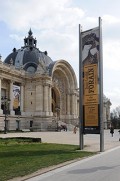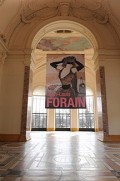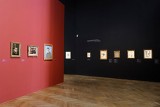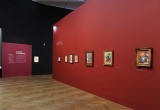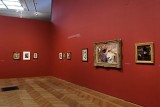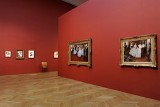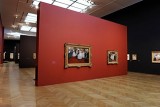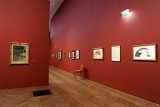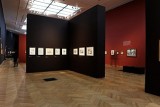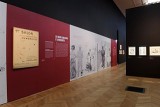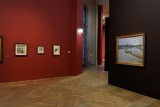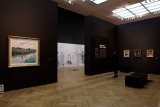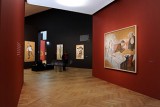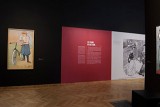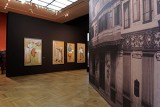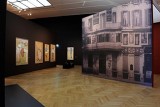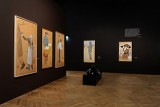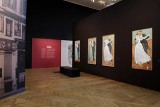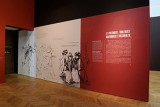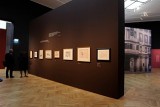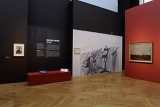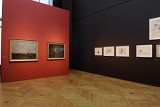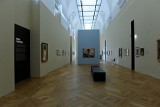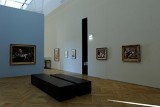The browser will either open the file, download it, or display a dialog.
Jean-Louis Forain (1852–1931), "La Comédie parisienne"
Petit-Palais, Musée des Beaux-Arts de la Ville de Paris
March 10–June 5, 2011
Dixon Gallery and Gardens, Memphis, TN
June 26–October 9, 2011
When Jean Louis Forain died in 1931, he had been regarded by no less an esteemed author and commentator on contemporary art than Guillaume Apollinaire, who considered Forain among the most significant of living artists. This opinion was also echoed by Édouard Vuillard, who found Forain's drawings equal to examples by Eugène Delacroix or Honoré Daumier, exemplary praise for an artist who quickly fell out of favor after his death. In recent decades, his work has often been totally neglected by art historians and museum curators save for the perspicacious collecting of Forain's work by the Dixon Gallery and Gardens in the United States.[1] Given the paucity of interest in Forain, and the lack of a consistent exhibition program to reassess his works, it is remarkable that the Petit Palais in Paris has launched this extensive retrospective, which examines all facets of Forain's long career with considerable depth, honesty and originality (fig. 1). The exhibition provides the astute visitor with insights into an artist who maintained close ties with certain members of the Impressionist group, especially Edgar Degas, but who also contributed to the Art Nouveau movement through decorations done for the Café Riche (1894–1899), originally located in the heart of Paris on the Boulevard des Italiens, but sadly destroyed before 1900.
Organized into thirteen thematic sections that follow the chronological evolution of Forain's development with only a few modifications to emphasize a phase of his work (such as his interest in portraiture), the exhibition provides an accessible overview of his complex career (fig. 2). There are also a number of stunning visual surprises in the show that carefully demonstrate why Forain was so beloved by other artists of his day. However, to fully appreciate these works necessitated persistence in viewing very small objects, often completed in gouache, pen and ink, or watercolor, a tendency that might "imply" preciousness in these pieces if it were not rewarded by a deeper understanding of why Forain's studies were so profoundly valued at the time they were originally created.
When a visitor moved beyond the opening credits, and entered into the first section of the show, the informational panels provided a capsulated biography of the artist revealing that, after a brief moment studying with Jean-Léon Gérôme, he was affiliated with the sculptor Jean-Baptiste Carpeaux, only to be thrown out of Carpeaux's studio for ostensibly damaging a sculpture (1869). Subsequently disowned by his family for following an artistic career, Forain led a Bohemian existence. He met the poets Arthur Rimbaud and Paul Verlaine; in turn, he became dedicated to literature using the pseudonym of Gavroche (a figure from Victor Hugo's Les Misérables) to sign some early works. Although he tried to establish an official career as an artist, Forain was rejected by the 1874 Salon jury. Immediately, however, he formed a liaison with the Independent artists (soon to be known as the Impressionists), becoming a regular member of the group that met continuously at the Café Guerbois or the Nouvelles Athènes in Paris. At this moment he bonded with Edgar Degas, a point underscored later in the exhibition when pages from a carnet document the numerous times that Forain drew Degas' portrait in varied poses, suggesting that he had became obsessed with his friend and with his work.
Within the first section of the show, which could be called either a prelude or an introduction, several issues are clarified. First, through a very sympathetic and life-like pastel of the writer J. K. Huysmans (fig. 3), Forain's ties with the literary world are further established. This point is underscored by etchings that Forain produced for Huysman's novel of a prostitute, Marthe (1879). While a provocative image of the woman, posed in a direct way, was rejected as the book's frontispiece, a second more sedate etching of Marthe holding a wine bottle demonstrated that publishers controlled the visualization of controversial literary types. It is a very telling visual comparison since it reveals that Forain's images were open to being censored if they emphasized the revealing aspects of mundane life.
Visitors who were familiar with some of the lesser known members of the Impressionist circle would also have seen parallels with the watercolors and drawings of Henri Somm, another artist, similar to Forain, who exhibited with the Impressionists. Forain's L'Ambulante au parapluie, replete with a poem by François Coppée, makes this association compelling, and makes the viewer wish that Forain's ties with other artists had also been more fully featured in the exhibition.[2] Other works included here, such as A la Guingette (1880) are documented as having been shown in the Fifth Impressionist exhibition, demonstrating a good bit of detective work on the part of the organizers although revealing that some of the ties with the Impressionists did not produce larger scale works by Forain early in his career.
In the second section of the show, titled "The Most Incisive of the Impressionists," Forain's career moves into high gear. While the wall text emphasizes the artist's interest in light and Japanese elements of design (then a craze with all artists), the works themselves stress Forain's acute ability to capture psychological nuances of character. Among these works is the remarkable Le Client (1878), a work done in pencil and watercolor that was first shown at the Fifth Impressionist exhibition. Suggestive of Edgar Degas' studies of prostitutes positioned for inspection inside a brothel, the inclusion of an old man watching the women conveys the atmosphere of sleaziness that was at the heart of both Huysman's novels and the way in which other artists focused on the prostitute as a symbol of human decay and wretchedness (fig. 4). Two other drawings in this section expand on Impressionist themes: Entrée au Restaurant (1879) and L'Anglais aupromenoir (c. 1879) both reflect Parisian nightlife while also revealing Forain's ability to capture qualities of different societal types. L'Anglais is also such an inspirational study that one wonders whether Henri de Toulouse-Lautrec knew it when he developed images of entertainers entering the space of the Moulin Rouge cabaret in his paintings and lithographs from the 1890s. A history of the provenance of these drawings, either in the exhibition label or the accompanying catalogue for the exhibition, would have been helpful.
With the Belles aux paillettes d'or (1879–80), a gouache of a single fashionable woman, Forain suggests another avenue of consideration. The young woman, encased in a tight-fitting dress, was able to attract attention through what she wore and the way she moved. These qualities are remarkably visualized in this work. But it is when a visitor studies Forain's works that focus on nightlife in the theatre that his drawings and paintings assume an even greater urgency. The Loge d'Actrice (1880), shown at the 1881 Impressionist show, was positively commented on by Huysmans in a published review; it is also a work that advances Forain's reputation as it shows how he was able to handle an internal light source (the lamp on the table) without sacrificing any nuance about the character of his actors. In this way, Forain remained current as there were any number of artists working with the theme of "sous la lampe" at this moment in time.[3] Forain's La Loge (1886) suggests another significant aspect of his work—the close relationship among the members of the Impressionist circle (fig. 5). This painting of the silhouetted head of a young woman in the theatre box, dressed in black, echoes the work of both Pierre Auguste Renoir and Mary Cassatt, and underscores the strong aesthetic connections among these artists. Since Forain's works are often not dated, pinning down these relationships can prove both tantalizing and elusive. But if this were actually possible, it would help solidify Forain's role and position within the Impressionist group as either an originator or a follower.
In the case of two other works in the exhibition, ties with Edouard Manet are directly advanced. Forain's Le Bar aux Folies Bergère, dated January 8, 1878, suggests the theme that Manet was to enlarge upon in his own Bar at the Folies Bergère of 1881. The positioning of the barmaid, the marble table from which she will serve drinks, and the reflective mirror behind her, creates a tangible image of what Manet would treat ambiguously in his work. The interest in reflective surfaces and the glittering qualities of brilliant artificial illumination used by Forain in this small watercolor certainly must have been noted by the older artist eager to remain au courant in the eyes of his younger colleagues.[4] The second work that speaks to a more complex relationship between Forain and Manet is Le Déjeuner. Although Forain's work is not specifically dated, making it difficult to assess which artist was the first to develop the theme of Chez le père Lathuille, the complex changes in the pose of the young woman in both works—that led to changes in how she was to interact with her male companion—suggest modifications that were carried out by both artists. While the discussion advanced in the Forain catalogue is not completely satisfactory, the fact that this small work, shown here for the first time, develops the concept that Forain and Manet were in a closer relationship than first thought.[5]
One other work in this section must not be ignored. With Le Buffet, (1884), Forain had a work accepted and publicly shown at the 1884 Salon. This large-scale oil painting (figs. 6 and 7), suggestive of scenes painted earlier by James Tissot, exemplifies another direction in his work: he wanted to succeed in the largest public arena of the time by showing a work with a socially acceptable theme. The aura of high society and people enjoying themselves at a gala event has been painted with particular attention to spatial issues, especially in the large open area at the bottom of the canvas. Here, Forain demonstrates a familiarity with the spatial innovations (drawn from Japanese art) that allowed him to construct an occult balance that speaks not only of Tissot, but also of Degas as informing his painting approach.
Considering all aspects of this section of the exhibition, the organizers worked hard to establish Forain's relevance. They made the case for Forain's influence on major artists and for his work being at the cutting edge of what was happening with the independent avant-garde. If one cannot accept these points, then much of what happened later on in the exhibition will not matter.
The next grouping in the exhibition "At the Opera" demonstrated Forain's relevance to modernism by showing his interest in backstage themes involving actual performers. A number of scenes were painted on fans (fig. 8); other images of dancers reveal Forain as being obsessed by their activity, similar to what his friend Degas was doing. Forain's Danseuse dans sa loge also shows his increasing fluidity in his approach to painting. While significant in showing how Forain was branching out to address a wider range of themes, this section also shows that his interest in illustration (he worked on many images used in popular newspapers and journals) had a tendency to weaken his commitment to more serious art objects. This tendency is not systematically examined in this area (figs. 9 and 10).
Although it was not clear how a visitor was to move through the next sections of the exhibition, the emphasis on" Caricatures and Lithographs," beginning in 1876, advanced the more commercial side of Forain's career. By 1887, everyone in Paris wanted his lithographic work; he had become so committed to satirical innuendoes that his images appeared to continue a direction established earlier by Honoré Daumier and Paul Gavarni. This aspect of Forain's career eventually led to his organizing his own journal, Le Fifre, and to his working for newspapers and journals from The New York Herald to L'Assiette au beurre. His ability to link words with images heightened his caustic commentary on the mores of contemporary life. Although the exhibition organizers presented this part of Forain's career correctly, they did not include any examples of the magazines in which he was published. By timidly limiting the number of works they included, and deemphasizing Forain's lithographic work—presumably in order to build his reputation around more serious examples—they conveyed the impression that his watercolors and paintings were what was known to the general public; in fact, what happened in actuality was just the opposite.
In the next section of the show, "Paris: Recording the Outdoor Scene," the organizers tried to unite Forain's caustic satiric ability with the advances made in Impressionist composition, emphasizing a broader range of compositional themes. The oil painting Jeune femme sur un Yacht (1885) reflected an intense appreciation for all things Japanese in a composition of a fashionable woman surrounded by Japanese lanterns. Souvenir deChantilly (1886), an example shown at the last Impressionist exhibition in 1886, reinforced the artist's sketch-like approach to a fashionable crowd, conveying a sense of flickering light, and an interest in recording Parisian high life at the racecourse in Chantilly. The effect of the canvas, including the presence of his girlfriend (later his wife) at the left heightens the attractiveness of a scene that many wanted to attend, but only a few could afford (figs. 11 and 12). As the wall text notes, Forain expanded his vocabulary of types, he focused on "the prostitute, the errand girl, the dandy, the pretentious bourgeois, the racecourse betters ... analyzing gestures, postures, expressions and psychology". He saw all these possibilities as expanding the parameters of modern life. One of the best paintings in the show was Le Pêcheur, in which a seated, somewhat forlorn figure fishes from a wooden plank that stretches over a waterway, accompanied only by his faithful dog (fig. 11). The comical aspects of the scene are knowingly revealed; simultaneously, the daring spatial diagonal and reliance on negative space complete the composition, stressing Forain's unification of two aspects—satire and daring compositional advances—in his best work of this period.
As Forain's career evolved through the 1890s, he was increasingly aware of colleagues' work in advancing the cause of interior or external decoration of a building. While he was seemingly uninterested in doing large-scale wall murals (Forain was too much of an intimiste to do this type of work), he was attracted to something decidedly novel when he agreed to do seventeen designs for mosaics on the exterior façade of the Café Riche building located on the Boulevard des Italiens and Rue Le Peletier. Many of the sketches are included in the exhibition although only two of the final mosaics are shown in the exhibition; instead, there was a large-scale photograph of the building's façade revealing how Forain's designs were to be employed (figs. 13, 14, 15, 16, 17, and 18). The startling use of scenes or types from everyday life on the front of a building was obviously shocking for the era. The building itself, with its large exterior mosaics emphasizing such themes as Confidence, The Waltz or The Cyclist, made it possible for the average citizen walking in the street to see how art images could attract him. Art was being popularized at the time, in many media including posters, and it is challenging to see how Forain was following this tendency in his own work. While this part of the show illustrated the novel way in which Forain responded to the necessary changes of the time, under the banner of an" art nouveau," much further study needs to be done on this building—on Forain's placement of the images and the overall symbolic scheme—in order to explain why the building was torn down in 1899, just a few years after it had been completed.[6] But by including the studies for the building in the center of the exhibition, the organizers have done Forain a significant service: they have demonstrated how he was changing his approach to creativity at a critical moment in time.
Other display sections emphasize different issues while raising significant problems with Forain and the current exhibition. The area dedicated to Forain as a polemicist who strikes out against the manipulations of lawyers and judges, effectively demonstrates that he was able to zero in on problematic issues while creating drawings and prints that owe a strong debt to Daumier (fig. 19). Many of the images were published in leading newspapers of the era, such as Le Figaro, Le Gaulois, or L'Écho de Paris, further establishing Forain's fame with the public. But these images are not his best work; too many were created to meet publishing deadlines. The artist, as is well-known, took a regrettable turn when he became an avid anti-Dreyfussard, founding a weekly, Pssst, in which many of his most anti-Semitic images were found, thereby fundamentally weakening the way in which Forain's work was, and remains, regarded by succeeding generations. His lithograph of a Scène de Grève uses a rather typical pose of a Jewish stereotype addressing his workers in an effort to get them back to work; the vitriol against the Jews is modestly found in this image although others are more virulent (fig. 20). His stance against Emile Zola, the great defender of Dreyfus, is similarly the basis for his image of Au Secours where Zola is symbolized as trying to aid the Germans with his publication of J'Accuse. Understandably, this was a difficult area to visualize in a show where the objective was to raise the level of appreciation for Forain as an artist. But to provide only a few of his polemical anti-Dreyfussard images, and not to place copies of Pssst in the installation, tends to sugarcoat this aspect of Forain's work. It simply does not help Forain's career.
As the show evolves, Forain's drawings and prints seem not only derivative of others, but also seem to be re-using figural types from earlier in his career. This is the problem with the area dedicated to his "Spiritual Quest," in which the works show how he strived to present various episodes from the Bible while trying to link them to contemporary life. Here, the organizers should have taken their cue from the paintings by Jean Béraud, from the 1890s, which follow the same direction, but provide a more effective visualization. It is apparent that Forain is losing steam.
With the images linked to World War I, called "Forain in Uniform (1914–1918)" due attention is given to his role as a war correspondent, to his working in the camouflage section, and to his becoming a spokesman for the common soldier who fought the war in the trenches. His series of La Borne Verdun (1916) reveal his compassion for those on the battlefields, but are the images as good as those by either Félix Vallotton or Théophile Steinlen done at the same moment? Further, with so many powerful World War I artists active in the trenches, especially Georges Scott, Forain's drawings and prints seem forced and often lacking in originality (figs. 21 and 22).
The show runs into even more trouble with the later thematic areas such as "The Nudes: From Naturalism to Exalted Sensuality," "Portraits and Self Portraits," and the "Dazzling Twenties." Many of the works do not support the thematic arrangement of the show as they continue to show Forain as derivative, losing his originality, and trying to garner attention when the world of the visual arts has passed by him. The paintings are often garish and unconvincing, suggesting that as he got older, he lost his way; the works have nothing to say to a younger generation, nor to visitors coming to the exhibition. It would have been more effective if the show had stopped before World War I, leaving all the later work out of consideration (fig. 23).
By the time one reached the show's conclusion, with the overwhelming statements of the period about how important Forain was, the exhibition reflects an attitude of overkill, of taking the artist and the show too seriously, and in believing the propagandistic statements of earlier artists or writers about Forain's lasting contribution (fig. 24). All of this leaves the visitor in a quandary about the work and career of Forain as presented here. First, and undeniably, Forain was a significant artist, one who merited this type of show where his importance to the Impressionists, as a caricaturist and a decorative artist in the Art Nouveau era, was brought out into the open. Second, by systematically assessing his work in a series of thematic categories, the organizers have tried to analyze and interpret his contribution. Even when Forain's later images in the exhibition do not warrant this type of consideration, the intellectual, didactic nature of the show is apparent and carefully considered. But in the final analysis, despite all of the care expended on building Forain's contribution, his later work vitiates his lasting contribution. He does not support the claims made by Apollinaire or Vuillard that he was among the giants of his time. And this may be the ultimate contribution of the exhibition and the catalogue that accompanies the show, melded cohesively together by Florence Valdes-Forain and the staff of the Petit Palais.
Gabriel P. Weisberg
University of Minnesota
Vooni1942[at]aol.com
The author thanks the staff of the Petit Palais for help in obtaining the installation photographs of the show. Similarly, without the aid and approval of Florence Valdes-Forain, this would not have been possible.
[1] For reference to the exhibition and to specific objects collected by the Dixon Gallery and Gardens, see Jean Louis Forain (1852–1931), "La Comédie parisienne", exh. cat. (Paris: Petit Palais, Musée des Beaux-Arts de la Ville de Paris, 2011). The publication was largely the work of Florence Valdes-Forain.
[2] For more on Henri Somm, see Elizabeth Menon, "Henry Somm's 'Japonisme,' 1881 in Context," Gazette des Beaux-Arts (February 1992): 89-98.
[3] See Musée de Saint-Maur-des-Fossés, Villa Medicis, Sous la Lampe, Peintures de 1830 à 1930, ex. cat, n. d. The exhibition was held from October 9, 2010 to January 16, 2011.
[4] See Jean Louis Forain (1852–1931), "La Comédie parisienne", 35-36. This point was not adequately stressed in the recent exhibition, Manet, The Man who Invented Modern Art, at the Musée d’Orsay, Paris.
[5] Ibid., 36.
[6] Ibid., 112-116. This is only a preliminary examination of these original drawings, as a number of studies still remain to be located. But this is an excellent beginning in an area where no previous research work has been undertaken.


